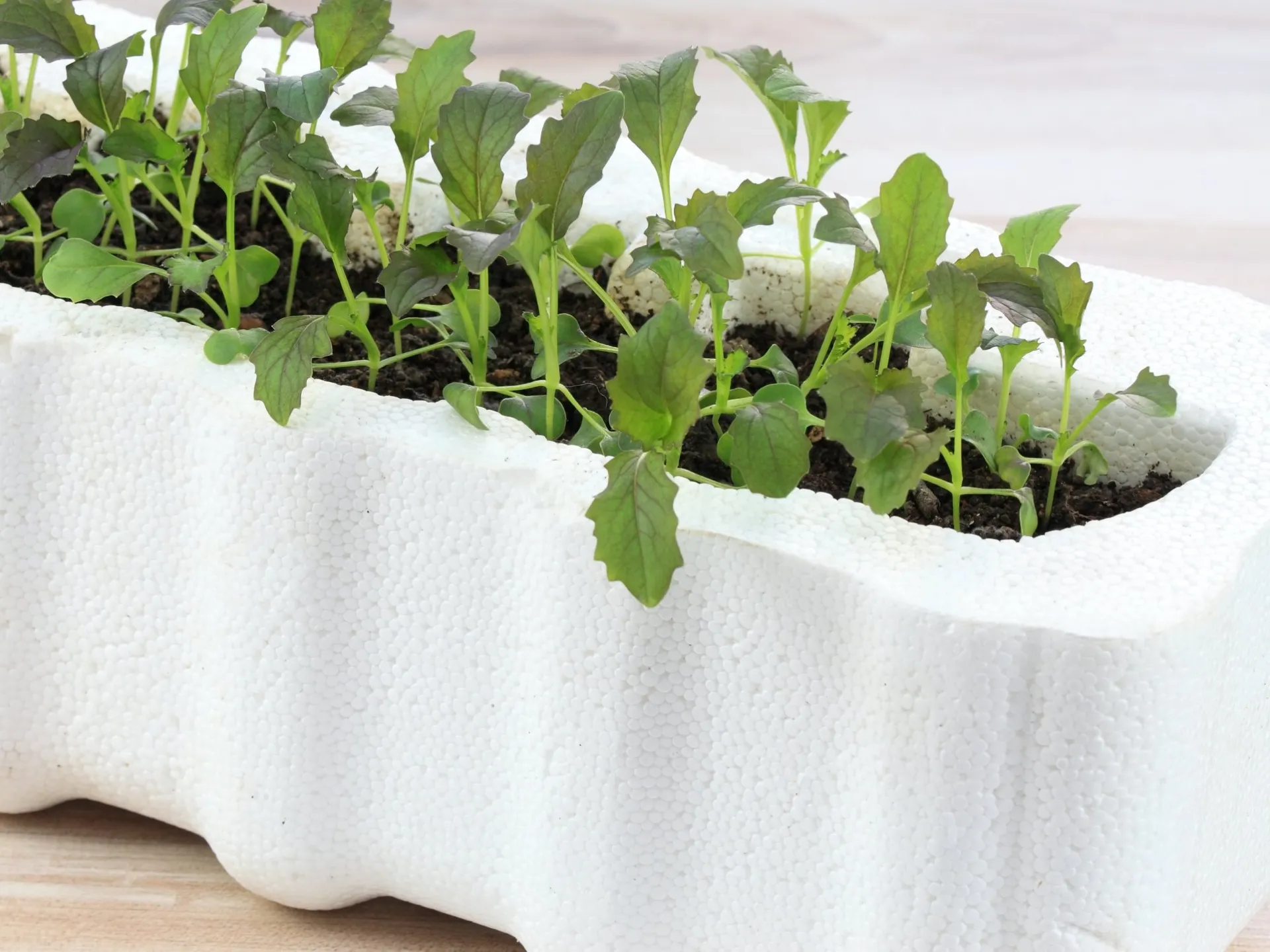Rozšířený polystyren (EPS) se stal jedním z nejběžnějších materiálů v moderní výrobě a stavebnictví. Pokud hodláte vyhodnocovat materiály z pěnových hmot pro balení, izolaci nebo průmyslové aplikace, pochopení vlastností, výhod a ekologických úvah EPS vám pomůže při informovaném nákupním rozhodování.
Co je to expandovaný polystyren (EPS)?
EPS je pevná, uzavřená buněčná pěna vyrobená z polystyrenových perliček pomocí jedinečného procesu rozšíření. Když výrobci aplikují teplo a tlak na tyto malé perličky, rozšíří se přibližně 40krát svůj původní objem, čímž vzniká materiál, který se skládá z 98% vzduchu a pouze 2% polystyrenu.
Tento proces rozšíření dává EPS jeho charakteristickou buněčnou strukturu, kde miliony uzavřených vzduchových buněk poskytují vynikající izolační a měkkostní vlastnosti. Materiál je druhým největším derivátem styrenu na světě, což odráží jeho široké průmyslové využití.
Základní vlastnosti, které jsou pro kupující důležité
Vynikající tepelné vlastnosti
EPS poskytuje konzistentní hodnoty R od 3,6 do 4,2 na palec tloušťky, čímž se stává jedním z nejkvalitnějších izolačních materiálů dostupných. Na rozdíl od některých alternativ udržuje EPS tyto tepelné vlastnosti během celého svého životního cyklu bez významného zhoršení.
Výborný poměr síly k hmotnosti
Navzdory své lehké kompozici (obvykle 0,7 až 3,0 liber na kubický palec), EPS poskytuje impozantní kompresní sílu. Tato vlastnost snižuje náklady na dopravu a zároveň udržuje strukturální integritu v náročných aplikacích.
Ochrana proti vlhkosti
Uzavřená buněčná struktura brání vstřebávání vody, což eliminuje obavy z plísní, hniloby nebo rozpadu. Tato vlastnost je zvláště cenná v stavebních aplikacích, kde je vystavení vlhkosti nevyhnutelné.
Ochrana před nárazy
EPS účinně absorbuje a rozptyluje energii nárazu, chrání citlivé produkty během přepravy a manipulace. Materiál se po malých nárazech obnoví svůj tvar, udržuje tak ochranný výkon během několika přepravních cyklů.
Chemická stabilita
EPS odolává většině vodných roztoků, alkoholům a slabým kyselinám, což zajišťuje kompatibilitu s různými aplikacemi. Nicméně, rozpouští se v organických rozpouštědlech, což by kupci měli zvážit při výběru balicích materiálů.
Hlavní aplikace v různých odvětvích
Balící řešení
Výrobci se spoléhají na EPS pro ochranné balení, protože materiál chrání produkty před otřesy, vibracemi a teplotními fluktuacemi. Materiál je vynikající pro přepravu elektroniky, lékařského vybavení, čerstvého ovoce a teplotně citlivých léčiv. Výroba na míru EPS balení poskytuje přesné přizpůsobení a optimální ochranu při minimalizaci hmotnosti balení.
Stavba a stavebnictví
Stavebníci integrují EPS do obálky budov jako izolační materiál pro stěny, střechy, základy a podlahy. Materiál přispívá k energeticky úsporným návrhům budov, které snižují náklady na topení a chlazení během životnosti budovy. Aplikace geopuštěniny využívají velké bloky EPS jako lehký plnivý materiál pro komunikace, náspy a podporu základen na slabých půdách.
Industriální aplikace
Kromě balení a stavebnictví výrobci integrují EPS do plavidel pro浮力设备、automobilní komponenty、vystavovací rámy a specializované výrobní formy. Snadná zpracovatelnost umožňuje složité tvarování na míru, které splňuje specifické požadavky aplikací.
Profil životního prostředí a udržitelnost
Kapacity recyklace
EPS 100% je plně recyklovatelný, a moderní recylační technologie zlepšily efektivitu a ekonomiku zpracování. Recyklovaný EPS může být použit pro nové balicí produkty, stavební materiály nebo trvalé výrobky, jako jsou rámce na obrázky a kancelářské potřeby.
Materiál má resinový identifikační kód #6, což pomáhá recylačním zařízením správně jej třídit a zpracovávat. Nicméně, kontaminace potravinovými zbytky nebo jinými materiály složuje recyklaci, takže čistá separace zůstává důležitá.
Efektivita dopravy
Vzhledem k tomu, že EPS obsahuje 98% vzduchu, výrazně snižuje dopravní hmotnost ve srovnání s alternativními materiály. Tato vlastnost se příměrně promítá do nižší spotřeby paliva a snížení emisí uhlíku během přepravy.
Integrace do kruhové ekonomiky
Vedoucí výrobci nyní navrhují produkty EPS s ohledem na jejich obnovitelnost na konci životnosti. Programy zpětného odběru a technologie komprimace snižují EPS odpad na 1/50. jeho původního objemu, což zajišťuje ekonomickou proveditelnost sběru a recyklace.
Výzvy a řešení
Hlavním ekologickým problémem je nevhodné odstraňování – EPS, který se dostane na skládky, zůstává tam po dlouhou dobu díky své odolnosti vůči biodegradaci. Kromě toho mohou lehké fragmenty EPS stát za znečištěním, pokud nejsou správně uchyceny.
Rozhodnutí zahrnují zlepšení infrastruktury sběru, pokročilé recylační technologie a vývoj biobáze alternativ. Někteří výrobci nyní vyrábějí EPS s přidateli, kteří urychlují degradaci za specifických podmínek, avšak tyto inovace vyžadují pečlivé hodnocení výkonových kompromisů.
Výběr EPS pro vaše aplikace
Při hodnocení EPS pro vaše specifické potřeby zvažte tyto klíčové faktory:
Požadavky na hustotu: EPS vyšší hustoty poskytuje větší kompresní pevnost a trvanlivost, zatímco nižší hustoty maximalizují izolační výkon za investovanou částku.
Ochrana proti hoření: Standardní EPS je hořlavý, ale výrobci nabízejí třídy s protipožárními vlastnostmi, které splňují stavební předpisy a bezpečnostní normy pro stavební aplikace.
Dimensional Stability: EPS udržuje svou tvar a vlastnosti v širokém rozmezí teplot (-300°F až +165°F), ověřte však, zda specifikace odpovídají vašemu prostředí aplikace.
Ekologické specifikace: Pokud udržitelnost představuje pro váš projekt prioritu, zeptejte se dodavatelů na obsah recyklovaného materiálu, certifikaci recyklovatelnosti a programy pro zpětné odběr.
Informování rozhodování
EPS pokračuje v dodávání hodnoty v různých aplikacích, protože vyváženě kombinuje výkon, ekonomickou efektivitu a všestrannost. Ustanovená infrastruktura pro recyklaci materiálu a zlepšující se ekologické postupy reagují na obavy o udržitelnost, přičemž udržují funkční výhody, které vedly k prvotnímu přijetí.
Pro aplikace v oblasti balení chrání EPS produkty při minimalizaci váhy při dopravě. V stavebnictví poskytuje spolehlivou izolaci, která zvyšuje energetickou účinnost budov. Klíčem je vybrat vhodnou třídu a hustotu pro vaše specifické požadavky a zajistit správnou správu na konci životnosti prostřednictvím ustanovených recyklačních kanálů.
Poznání těchto vlastností vám pomůže posoudit, zda EPS odpovídá vašim technickým specifikacím, rozpočtovým omezením a ekologickým závazkům – což vás osvobodí k tomu, abyste mohli učinit nákupní rozhodnutí, která slouží okamžitým potřebám a dlouhodobým cílům vaší organizace.
Často kladené otázky
Je EPS bezpečný pro aplikace v kontaktu s potravinami?
Ano, EPS je schválen FDA pro kontakt s potravinami a široce používaný v balení potravin a nádobí. Materiál je chemicky inertní a neuvolňuje škodlivé látky do potravin. Poskytuje vynikající izolaci, která udržuje teplé potraviny teplé a studené potraviny studené, což jej činí ideálním pro přepravu a skladování potravin.
Jak se EPS srovnává s XPS (vysunutý polystyren) pro izolaci?
Oba materiály nabízejí vynikající izolaci, ale liší se v klíčových aspektech. EPS obvykle stojí o 20-30 % méně než XPS přičemž poskytuje podobné hodnoty R na palec. XPS nabízí vyšší kompresní pevnost a mírně lepší odolnost vůči vlhkosti díky své hustší a rovnoměrnější buňkové struktuře. Pro většinu stavebních aplikací EPS poskytuje srovnatelný výkon za nižší cenu, což jej činí oblíbeným výběrem pro cenově citlivé projekty.
Mohu recyklovat EPS balení z produktů, které jsem zakoupil?
Mnoho komunit nyní přijímá čistý EPS pro recyklaci, avšak dostupnost se liší podle místa. Zkontrolujte svůj místní recyklační program nebo vyhledávejte místa pro odložení prostřednictvím webových stránek EPS Industry Alliance. Mnoho obchodů, které prodávají produkty doručené v EPS, také udržují sběrné programy. Klíčem je zajistit, aby EPS byl čistý a svobodný od kontaminantů, jako jsou zbytky potravin nebo lepicí pásky.
EPS se časem degraduje nebo ztrácí své vlastnosti?
EPS prokazuje vynikající dlouhodobou stabilitu, pokud je chráněn před dlouhodobým UV zářením a mechanickým poškozením. Laboratorní testy a terénní studie potvrzují, že správně nainstalovaná EPS izolace udržuje svou tepelnou účinnost po dobu 50+ let. Materiál odolává vlhkosti, nepodporuje růst plísní a neztuhne ani se nekomprimuje za normálních podmínek, což zajišťuje konzistentní výkon během celého životního cyklu.
Jaký je rozdíl mezi EPS a Styrofoam™?
Styrofoam™ je registrovaná ochranná známka společnosti Dow Chemical pro jejich extrudovaný polystyren (XPS) pěnu, která je obvykle modrá nebo růžová a používá se převážně v stavebnictví. EPS je jiný materiál – rozpustný polystyren, který je obvykle bílé. I když oba materiály pocházejí z polystyrenu, používají se různé výrobní procesy a mají odlišné vlastnosti. Tyto termíny nelze zaměňovat, ačkoliv se slovo “Styrofoam” v běžné řeči (a nesprávně) používá k označení všech pěnových obalů na jídlo a balení, které jsou vlastně vyrobeny z EPS.



